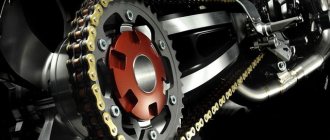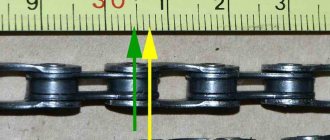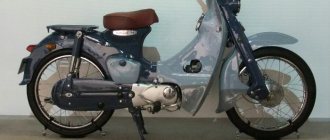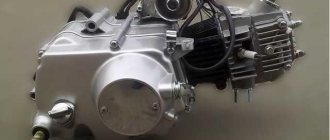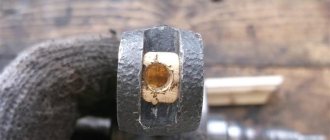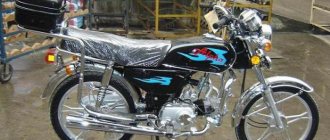How to set timing marks on an alpha moped
Checking the timing belt by marks on the Delta EX 50 moped engine 1P39FMB (139FMB)
Comments from those interested:
Roman Khimchenko 2 weeks. reverse And if it doesn’t match WHAT to do
Vladimir Voronov 2 weeks. reverse Set it to match.
Vladimir Voronov 1 month ago This is nice. )) And of course there will be new videos, just wait a little.
Vladimir Voronov 1 month ago Yes! Another thing, don’t install two gaskets; it won’t make things any better; an increase in the combustion chamber will result in a drop in power.
Hunter38767 3 weeks reverse And if you have a 50cc head and a 72cc piston, then you need to change the head.
Hunter38767 3 weeks reverse Two gaskets are not allowed, look, the valves may be overtightened, unscrew the two caps on the head, and look at the gap, it should be 0.05 on the feeler gauge. But if they hit the piston, then there is no gap.
Sergey Vasiliev 1 month back Vadim, thank you, I read a lot of useful information, thank you, I will be glad to see new videos on alpha, I’m really looking forward to it
Arkady Novoselov 1 month back, well done, thank you for you!
Den1309 › Blog › Replacing the timing chain on an Alpha and Orion moped.
Good day to all!
As I wrote earlier, you can read it here. the time has come to change the timing chain, as well as the chain guide, tensioner and camshaft sprocket... But first things first. I purchased: a set of gaskets and, accordingly, the spare parts described above: To prevent oil from leaking out, we tilt the moped on its side. The valves are already adjusted in advance. There is a link above.
Next, we remove the rotor cover, and to do this we had to remove the front step, the gear shift pedal, and disconnect the wires.
The rotor nut is no longer in the photo, I unscrewed it with great difficulty - I even bent my 14mm spanner, I had to ask my neighbor for a stronger one. The photo shows that everything here is “neglected,” so the renovation was not in vain (it put everything in order). And again he turned to his neighbor for a puller to remove the rotor. Here's another very important point
on the back side of the rotor there are 6 rollers with 3 springs and 3 grooves for fastening (sorry I didn’t take a photo), SO it’s important not to lose all this when removing the rotor. Well, we remove everything that is described in red in the picture and continue further.
Remove the cover and leave the chain guide bolt alone for now. Here we see the following
I broke the timing chain when I tried to stop the rotor in order to unscrew the nut on it, so I drew with a highlighted arrow how it should be put on. And the order is as follows: Unscrew the chain tensioner bolt, remove the spring and the tensioner itself. Then we unscrew the bolt of the chain guide and if the guide is not removed yet, then no big deal, it will easily come out together with the chain (the guide is similar to the timing chain tensioner wheel, only without teeth, and in place of the teeth it’s like a solid rubber band (all the same if the teeth are connected into a single whole)) and unscrew the 3 bolts of the camshaft sprocket - remove the sprocket itself... Then, to put on a new chain, we pass a thin wire into the hole (where the damper was) from the camshaft sprocket to the oil pump drive sprocket - tie the chain and remove it. Afterwards, I inserted the damper (the chain has not yet been untied) from the oil pump sprocket - inserted it and adjusted it with a regular screwdriver, then fixed the damper with a bolt, put on the timing chain, as shown by the highlighted arrow, put on the camshaft sprocket - without forgetting about the marks, see the article Adjustment..., After installing tensioner with a spring and a bolt and assembled everything in reverse order. And since the timing chain was broken, I had to tinker with the settings so that everything would match the marks given in the link. That's all for now everyone! Good luck on the roads, good mood and reliable equipment.
Source
How to Tension the Timing Chain on an Alpha Moped
Photo report: how to check the drive chain of a scooter?
In life it is always like this: one wonderful thing, another bad. The same principle applies to various types of manual transmissions. Chain transmission was no exception. On the one hand, there is nothing simpler, more reliable, simpler, more compact and cheaper than a chain drive.
On the other hand, we get endless hemorrhages with chain stretching, sprocket wear, endless cleaning and lubrication, maintenance and stretching of the chain itself. But nothing can be done, the gearbox has many advantages over other types of mechanical gears, since these types of gears are used almost everywhere.
In general, now we will not talk about the chain drive as such, but about a method for diagnosing chain synchronization, which drives the scooter .
To change or not to change?
Let's say you're using most of your engine: you're replacing gaskets, crankshafts, gaskets and other things, but you're hesitant about replacing your timing chain with a new one. There is no doubt in your mind that you should replace it with a new one as soon as possible. And now I will explain why.
See for yourself: the average lifespan of a chain is approximately 18,000-20,000 km (personal experience), which is approximately the same as the average life of the engine itself. And for example, after driving 6000 km, the crankshaft jammed or the engine leaked, or something else that required complete disassembly of the engine. Naturally, you disassemble the engine, replace the crankshaft with a new one and leave the chain, which by that time has exhausted a third of your resource.
READ How to Twist Mileage on Accent
So what's going on? After 12,000 km the chain will fail and become unusable and the crankshaft and other parts will start to work and you will, if not want, have to halve the engine again through one chain. It's necessary? The chain is a consumable item. Never skimp on this!
check
Personally, I never check the time. I just throw them in the trash, no matter how wonderful they seem to me. For me it's a chain. This is a consumable item, the same as a spark plug, oil or oil seal. But if it's important to you or money is stressful, you can use your old grandfather.
Alpha tensioner repair
Tensioner repair £149.
We stretch the chain along its length, squeeze it with our fingers and try to position it in a horizontal position.
READ Replacement Timing Chain Volkswagen Jetta 1.4
To be clear, I took a new and very worn chain, connected them and checked for horizontal bending. As you can see: the new chain (above) has made a slight arc and is worn and no good, like snot, almost 90 degrees.
The worn chain was almost an inch longer than the new one.
How to replace the chain of scooters?
It's very simple, friends: remove the engine from the frame, disassemble it and replace the chain with a new one. There are no special secrets in this, and there are also no special ways to cheat fate without disassembling the engine. The chain can only be replaced by completely disassembling the engine.
The timing chain is not intended to be riveted or riveted in any way. It can be easily twisted or twisted while riveting and this is the correct way to ensure that the chain in the engine is pushed against the sprocket and luckily it can work and possibly bend the valve. And one more thing: a beginner will not be able to rivet a quality network. This work is not as simple as it might seem at first glance. So don’t suffer from debris, but disassemble the engine.
READ Replacing Timing Chain Honda Cbr 600 Rr
How to set the chain to pull?
But you won't receive or configure it, and it won't interfere with Google or Yandex searches with such queries. The chain in the scooter engine is tensioned automatically. And if it is stretched so far that it begins to fly or jump through its teeth, feel free to disassemble the engine and replace it with a new one. There are no miracles there.
Checking and adjusting the moped drive chain
The chain drive is one of the most loaded components in a moped.
If the chain is loosely tensioned, that is, it sags a lot, then at the moment of a load change, this excess supply of chain will first be selected, and then, when its free play ends, a sharp blow will occur, harmful to all elements of the transmission. And it’s unpleasant for the driver himself to drive such a moped that jerks whenever the gas is opened or closed, especially in a sluggishly creeping traffic jam. The second disadvantage of a sagging chain is that when the tension is weak, its unloaded shoulder tends to move in a straight line by inertia, which is why it rests imperfectly on the sprocket teeth, thereby wearing them and itself out. The life of the drive chain depends on lubrication and adjustment. Failure to maintain the drive chain promptly can result in premature wear or damage to the chain and sprockets. Chain maintenance work includes cleaning it from dirt, lubricating the links, or boiling it in molten lubricant. Cleaning the chain and lubricating its links can be done without removing the chain from the moped, using a brush, special liquids and lubricant in aerosol packaging.
To weld the chain, it must be removed from the moped, washed in kerosene and boiled in lubricant (the lubricant consists of 95% solid oil and 5% graphite powder) at a temperature of 70-80°C. It is recommended to carry out the first welding of the chain before use.
A routine check of the drive chain tension is carried out every 500 km.
The check includes:
- Turning off the engine, place the moped on the central support stand;
- engage neutral gear;
- remove the inspection hole cap on the chain casing;
- check the chain tension (normal sagging of the drive chain should be within 5-10 mm with a force of 10 kgf;
- Turning off the engine, place the moped on the central support stand;
- engage neutral gear;
- loosen the rear wheel axle nut;
- by tightening the adjusting nuts on the left and right sides, achieve normal chain tension;
- tighten the rear wheel axle nut;
After the adjustment is completed, you need to check if everything worked out as expected. If the wheel is level, the marks on the tensioners on the right and left show the same thing, and the chain has the desired slack, then everything is done correctly. All that remains is to lubricate the chain.
Read also: Installing the Mazda 6 belt
A distinctive feature of a moped from a scooter is that the former has a chain instead of a belt, so sooner or later quite typical breakdowns occur with Alpha mopeds. The chain tends to stretch over time, after which movement becomes quite problematic. You can tension the chain yourself; no special skills are required. But know that you don’t need to tighten the chain on the Alpha moped too much; the free play should be from 2 to 3 cm, otherwise you will face much bigger problems.
So, if you don’t know how to tighten the chain on an alpha moped, follow the instructions below.
First of all, remove the passenger footrest so that it does not interfere with tensioning. Then place the alpha moped on the center stand. But some experts recommend tensioning under a certain load on the moped, because on the center stand your vehicle will be supported by weight; after tensioning the chain, you will notice that it has become even more tense, like a string. This oversight leads to serious damage; many say that an overtightened chain after 1 thousand km leads to a breakdown of the entire clutch mechanism.
How to tension a chain on an Alpha moped
Next, you will have to unscrew the nuts of the central axle of the wheel, this will help loosen the wheel axle. To do this, a 14mm wrench is suitable, after that you will have to unscrew the nut located on the same axis, but then, in the case of the Alpha moped, a 24mm wrench will do. After this, we proceed to adjust the chain; on the same axis there is a chain tensioner with a nut, just enough tighten it, this will require a 10mm wrench.
You will have to tighten the nut until you feel that the chain is tensioned. In this case, the teeth should not fall on the edge of the chain, check this, and only then can you begin the final procedure - tightening the axle nuts back. Tighten these nuts well, but do not overtighten them. That's all, as you can see, tensioning the chain on an alpha moped is quite simple.
Photo report: How to check the timing chain of a scooter?
It’s always like this in life: one thing is great and the other is bad. Exactly the same principle applies to various types of mechanical transmissions. Chain transmission is no exception here. On the one hand, there is nothing simpler, more reliable, lighter, more compact and cheaper than a chain drive.
On the other hand, we get endless hassle with stretching the chain, wear of the sprockets, endless cleaning and lubrication, maintenance and tensioning of this very chain. But there is nothing to be done, the chain box has a lot of advantages over other types of mechanical transmissions, which is why these types of transmissions are used almost everywhere.
Read also: Chain cleaning machine
In general, now we will not talk about the chain drive as such, but about the method of diagnosing the timing chain driving the camshaft of a scooter engine .
How to replace the timing chain in an engine
Having decided on such an action as replacing the timing chain of a scooter, you need to decide on how to implement your plan.
There are two replacement options:
How to change, everyone decides for themselves. Both methods, advantages and disadvantages are described in detail below.
With disassembly
You should choose the right tools - generator and variator pullers (you can make them yourself), a kickstarter sprocket puller, 8, 10, 12 and 17 mm sockets, a hammer, two screwdrivers (flat, Phillips).
The engine is removed from its place, the oil is poured out, all parts are wiped and cleaned. Next, remove the muffler and cooling casing. We remove the generator only with a puller. To do this, unscrew the bolts from the impeller and remove it from the rotor. It is necessary to fix the rotor with a puller and unscrew the nut. Then we tear the rotor off the crankshaft journal. Remove the variator cover. Also, secure the impeller with a puller, unscrew the nut, and remove the variator from the axle.
Below the variator is the kickstarter gear. Likewise, a puller is required for it. Then we clean the cylinder connector, valve covers and cylinder head. After unscrewing the bolts on the valve covers, remove it. Next, remove the scooter's timing chain tensioner. After unscrewing the bolts on the cylinder head, we pull out the camshaft bed.
Next, remove the chain from the camshaft and pull it out of bed. To avoid losing the guide bushings that center the parts relative to each other, you need to remove them and put them away. We remove the cylinder head, the cylinder itself, and the piston (to do this, remove the retaining ring and pin from the upper connecting rod head).
After unscrewing the bolts on the crankcase cover, tapping it a little, remove it from the engine. We take out the starter intermediate gear, use a screwdriver and a hammer to unscrew the overrunning clutch nut (clockwise) and remove the gear and housing from the trunnion. We reached the chain!
Remove the protective shield from the oil pump. Place a metal stick under the chain, twist the nut on the oil pump sprocket, remove it and remove the chain.
No disassembly
We take the following tools: a Phillips screwdriver, pliers, a new chain and a special puller. More details about it will be below. We flare the new chain - to do this, use a puller to press the pin out of the joint of the links, but not completely.
A little about the puller
It is called a timing chain puller. It can be made by a turner by turning a threaded extruding pin and rolling a strong pin into it with a diameter similar to that of a chain pin. You can purchase a ready-made bicycle one. Just narrow the pin a little to the desired size.
Remove the cooling casing from the scooter engine, then the cylinder head cover. Next you need to remove the chain tensioner. We remove the camshaft bed, take out the shaft, remove the star.
We take the puller, center it with the pin, and gradually press out the pin. You can press it out completely, it will not be useful. We compare the links of the new and old chains, thread the wire into the seat of the pin and fix the ends of both chains. We turn the cooling impeller counterclockwise, gradually replacing the old chain with a new one.
Then we separate the ends of the chains, throw out the old one, and combine the new links from the ends. We check the alignment, install the pin, and use pliers to carefully press the pin in so as not to damage the new chain. We first check the mobility of the links. We finalize the pin with a puller. Again we control mobility. This point is very important: if you install the pin unevenly and miss it, it will begin to rest against one of the links and squeeze out the next one.
As a result, the subsequent pin or link bends, causing it to jam and become immobile.
Next, we assemble the engine in reverse order, placing marks on the rotor. When installing the camshaft bed, after tightening the nuts, you need to check the valve clearances with a feeler gauge. Upper valve – inlet: 0.05mm, lower – exhaust: – 0.1. The feeler gauge should fit freely between the valve and the adjusting bolt.
Then install the chain tensioner. We unscrew the bolt on the top of the tensioner, install a screwdriver in the groove, and, turning it, push the rod back. We fix everything else back according to the diagram.
Source
How to adjust and tension the chain?
There’s no way you can tighten it or adjust it, and you don’t bother Google or Yandex search with such queries. The chain in the scooter engine is tensioned automatically. And if it has already stretched to such an extent that it begins to fly off or jump over the teeth, feel free to disassemble the engine and replace it with a new one. There are no miracles.
And I will prove this to you now. The chain in the engine is tensioned using a special tensioner, which operates in a fully automatic mode. As the chain stretches, And the more the chain stretches, the more the rod will come out. But! The rod has a limited stroke: on a completely new chain it comes out about a third of its stroke and then, as it stretches, it comes out completely and then it won’t come out anymore. Therefore, the chain will no longer be tensioned! And all your attempts to correct the situation will lead to nothing.
Source
Setting the timing belt on a delta moped
1. Install a new cylinder head gasket.
ATTENTION!
The cylinder head gasket is made of soft metal (copper, aluminum) and after tightening the cylinder head nuts it is deformed, thereby ensuring a tight connection. Reinstallation of the cylinder head gasket is not permitted.
2. Install the timing chain guide.
3. Install the cylinder head.
4. Set the piston to TDC according to the marks on the flywheel. This is usually the "T" mark on the flywheel. Align the mark with the tide on the engine crankcase.
ATTENTION!
The following operation is one of the most important when assembling the engine. It is important to align all the marks very accurately. An error in installing the chain even by 1-2 teeth will result in the engine not working correctly, and it will probably even lead to serious damage to the timing and cylinder-piston gas parts when trying to start the engine!
5. After making sure that the timing chain has not jumped off the drive sprocket on the crankshaft, install the camshaft into the cylinder head, at the same time putting a chain on its sprocket so that the marks on the camshaft sprocket are parallel to the plane of the edge of the cylinder head, and the cams are directed downward (inside the head).
6. Install the rocker arm support, orienting it according to the installation marks. Lubricate the cams and camshaft bearings.
Video on this topic
repair of alpha tensioner 149 fm.
Replacing timing rollers 139FMB (1P39FMB)
Why does the timing chain rattle in Racer Alpha? and how to remove it!
Subscribe to the channel and post how!
#41 How to determine the alpha chain stretch of a magnifying glass?
Subscribe to the channel) Link to vk-https: //vk.com/id352703079 My group vk-https: //vk.com/club116536286.
Modification of Delta with a tricky time change
How to replace the oil pump sprocket without disassembling the clutch basket. Chinese moped Delta 72cc.
replacing a Gm chain in an ALFA moped
Spare parts for scooters in Belarus Online store in Belarus https://scooterbaza.by/ Group in contact https://vk.com/scooterbaza.
Alpha 110 (Change timing chain)
They brought in a moped (Alpha 110) with a complaint about a foreign knocking noise in the engine, as it turned out that it was loose timing chain. Foam.
Replacing the camshaft tensioner and Delta timing belt
Alpha 110 (Replacement of magnet chain)
Foam filter for Alfa moped https://goo.gl/MF6F3b Digital thermometer.
Before you start adjusting the valves
Therefore, after purchasing a new Alpha RX, I checked the valve clearance. For this procedure I had to buy a set of probes. In our case, you will need a probe with a thickness of 0.05 mm.
In order to calmly begin adjusting the valves, I had to unscrew the safety bars. For this we need a key of 8.
To get to the valves, you need to unscrew the valve covers located on the top and bottom of the cylinder head. To do this we need a 17 wrench. I used a spanner.
Let's start adjusting the valves
Let's start with the intake valve, which is located at the top of the cylinder head. We'll need a key for 9. Yes! Not 8, not 10, but 9! Good thing I had a set of sockets in the car. But it is better to use a spanner wrench, which conveniently unscrews the pusher fixing nut on the rocker arm.
Then we need a feeler gauge with a thickness of 0.05 mm, which must be inserted between the pusher and the valve stem. By rotating the pusher, we reduce or increase the thermal gap until the probe moves with slight tension. After tightening the fixing nut, we again check the gap with a feeler gauge, which could have gone astray.
In a similar way, we begin adjusting the exhaust valve.
Setting TDC on Alpha
To start adjusting the valves on the Alpha moped, you need to set the top dead center. To do this, remove two covers on the rotor cover. Rotate the rotor until the T mark appears.
To accurately control this process, you need to remove the timing sprocket cover. To do this, on the opposite side you need to unscrew the clamping bolt, which can be unscrewed with a 10mm wrench. Remove the timing chain sprocket cover carefully so as not to damage the gasket.
The star has a mark in the form of a dot. It should be aligned with the mark on the head body.
To easily turn the engine mechanisms, I unscrewed the spark plug, reducing the compression to nothing.
Now you can begin adjusting the valves on the engine.
How to tension a chain on an Alpha moped - step-by-step instructions
To simplify access to the necessary components, first remove the rear left passenger footrest. The moped must be placed on the center stand. It is also advisable to unscrew the bolt and remove the exhaust pipe. If this is not done, the ratchet heads cannot be used.
Next, take two keys - 17 and 14 mm. You need to unscrew the nut to loosen the wheel axle. The nut is unscrewed, but not completely. With the second key you need to hold the axle on the reverse side so that there is a stop. If you don't hold it on the reverse side, the axis will spin.
To change or not to change?
Suppose you are overhauling your engine: changing oil seals, crankshaft, gaskets and other devices, but you doubt whether to replace the timing chain with a new one or not. If you have any doubts, change it for a new one at the first opportunity. And now I will explain why.
See for yourself: a chain has an average service life of approximately 18,000-20,000 km of a scooter (personal experience), approximately the same as the average service life of the engine itself. And for example, after driving 6,000 km, the crankshaft jammed or the engine leaked, or something else happened that requires complete disassembly of the engine. Naturally, you disassemble the engine, replace the crankshaft with a new one, and leave the chain, which by that time has exhausted a third of its service life.
And what happens? The chain, after 12,000 km, will exhaust its service life and become unusable, but the crankshaft and other parts will be in good order and whether you like it or not, you will have to halve the engine again, because of the chain alone. Is it necessary? The chain is a consumable. Never skimp on it!
Personally, I never check timing chains. I simply throw them in the trash, no matter how awesome they seem to me. A chain is a consumable item for me, just like a spark plug, oil or oil seal. But if you are important, or money is tight, you can use the old fashioned way.
Examination
Personally, I never check timing chains. I simply throw them in the trash, no matter how awesome they seem to me. A chain is a consumable item for me, just like a spark plug, oil or oil seal. But if you are important, or money is tight, you can use the old fashioned way.
Alpha tensioner repair
alpha
Tensioner repair 149 fmb.
We stretch the chain along its length, hold it with our fingers and try to position it in a horizontal position
- If the chain describes an arc that looks very much like a 90-degree angle, then feel free to throw it in the trash.
- If the chain bends slightly and describes a small arc, then such a chain is quite suitable for further use
For clarity, I took a new and heavily worn chain, put them together and checked for horizontal deflection. As you can see: the new chain (above) described a barely noticeable arc, while the worn and useless chain sagged like snot, almost at an angle of 90 degrees.
The worn chain turned out to be almost a centimeter longer compared to the new one.
Read also: Deprivation of rights through court
Valve adjustment on Alpha
I want to touch on an interesting topic that everyone has heard about, but not everyone understands its essence - let's talk about valve adjustment.
A little theory.
First, a little theory. Where did the need to adjust the valves come from and why is the thermal gap needed?
Any four-stroke engine has at least two valves: an intake valve, through which the working mixture enters the combustion chamber, and an exhaust valve, through which exhaust gases exit. Part of the valve is constantly located in the combustion chamber and therefore the valve becomes very hot. And as we know from school physics courses, bodies expand when heated. Moreover, the stronger the heating, the greater the expansion.
The valves in the engine are always in a “spring-loaded” state, while the valve plate is pressed very tightly to its seat - the valve seat. This ensures that the valve closes tightly.
To open the valve, you need to press on it. In our case, the valve is pressed by a rocker arm, which moves under the influence of the camshaft cam.
Now let’s imagine that the engine is cold (it stood for several hours and all the parts cooled down to “room” temperature). If you start the engine, the valves will begin to heat up quickly and, as a result, lengthen. If you do not leave it room for expansion (the gap between the rocker arm and the valve stem), then the moment will come when the valve will elongate so much that it will not fit tightly to its seat and will begin to leak gases from the combustion chamber. This leads to a loss of engine power and can also lead to overheating and burnt valves.
IMPORTANT: the gaps are set on a cold engine , when the valve has not yet had time to lengthen.
What happens if the valves are adjusted incorrectly?
Very often on various forums questions are asked: “What will happen if the valves are adjusted incorrectly?” There are two possible options:
Thus, too little clearance is much more dangerous than too much. It is for this reason that it is not recommended to set gaps “by ear” without feeler gauges. If there is a feeler gauge between the rocker arm and the valve, there will already be a gap between the rocker arm and the valve, unless of course you clamp it with great force.
Why combine tags?
The valves must be adjusted in a position where the rocker arm does not press on the valve stem, that is, the valve is closed. When a four-stroke engine is running, both valves are closed at the end of the compression stroke, so for ease of adjustment, align the mark on the camshaft sprocket with the mark on the head housing. This position corresponds to the top dead center - the end of the “compression” stroke and the beginning of the “power stroke” and both valves are closed at this moment and can be adjusted.
By and large, it is not necessary to clearly combine these marks, because both valves close already at the beginning of the compression stroke and do not open until almost the end of the power stroke, that is, the valves are closed at least half a revolution. That is, there is nothing to worry about if you “overshoot” the mark a little, or if you don’t reach it a little (within reasonable limits, of course).
For some reason, some “craftsmen” in their video instructions combine the “T” mark on the crankshaft flywheel. It is not necessary to do this to adjust the valves. For one revolution of the camshaft, the crankshaft makes two revolutions, and the mark will coincide twice: once at the end of the compression stroke, and the second time at the end of the exhaust stroke (when the exhaust valve is still open and the intake valve is preparing to open).
What should the valve clearance be on an Alpha?
The intake valve clearance on most engines is usually less than the exhaust valve clearance. This is due to the fact that the intake valves heat up less. They are cooled by fresh air flows.
The thermal clearance of the intake valve for the 139FMB engine is 0.03 mm. For the exhaust valve, the gap is 0.05 mm.
